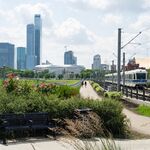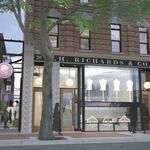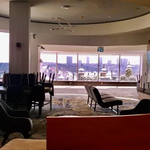Lots of up and coming African cities and a bunch in south east Asia have almost no "high quality" architecture but nevertheless seriously impress you with their presence, pace, etc.
Edmonton has more in common with these boomtowns in some respects.
I still think we're properly in the league of major midsized and moving towards larger global city based on where the population is going. This is a separate question from architectural quality.
On architecture quality, I want Edmonton to develop more of its own unique style, and not just look to Toronto or Vancouver or what's trendy in uber-expensive cities around the world.
Edmonton has 1.5 million people, little significant corporate presence, and an economy based on a (slowly) dying industry. I don't think Edmonton's necessarily going to stall, but I'm not sure the high-growth we've seen for much of the last half century plus will hold up for the next half century. But who knows, right? The only factor I could see changing this is if the climate crisis produces a lot of migrants and Canada is willing to accept them, as cities such as Edmonton will be well suited to that kind of relocation.
I also don't know if you're realizing how far Edmonton would have to go to become a truly big city of >5 million. Toronto took 50 years to go from 1.2 million in 1951 to 5 million in 2001. And that's with it being one of the main national valves for immigration for the entirety of that period. Toronto grew very fast, and continues to grow very fast, but gaining that much population generally takes a while. New York's metro area similarly took 50 years to go from 1 million in 1850 to 5 million in 1900. And by the time Edmonton hypothetically reached 5 million, Toronto would have 15. In that kind of world, the goalpost for what is considered big likely would've moved upwards, with more and more large centres, much like in 1850, New York with less people than Edmonton today was a bona fide big city for its era because there wasn't much bigger. I don't see Edmonton jumping ahead in tiers like it did in the late 20th century. And regardless, 50 years is hardly quick in human timescales; it's the majority of our avg lifespans, so I can't really agree that Edmonton's "moving towards" being a "larger global city."
Another thing is 50 years from now, in the 2070s, you're looking at global population growth slowing, after likely peaking in the 2040s-2050s. This trend will have already begun in rich, Global North countries such as Canada. By the end of the century, the population of humanity is predicted to start dropping. Now, obviously predicting that far out is a bit of a gamble, but this is something I've followed for about 15 years now and the tune hasn't changed among top demographers. There is a long range trend across the world towards having fewer children. The only reason Canada is still able to grow as much as it does is because of immigration, and if the pools of places from which we get immigrants from isn't even producing many kids, while their living conditions (hopefully) improve, there's going to be less people moving to Canada, barring some large-scale climate refugee relocation.
So I doubt Edmonton will hit today's minimum threshold for a big city, of about 5 million. Maybe Edmonton will have 3 million people in 50 years - that seems more plausible and still involves a doubling in population. That's significantly bigger and will allow the city to command more resources and amenities. But it'll just be where Denver and Tampa are today. Nobody considers these big cities on the global stage. Edmonton will have continued prominence domestically, but its size relative to others probably won't change much in the ensuing decades. It'll still be dancing around Ottawa and Calgary. Edmonton may have 3 million, but Toronto would have 9, Montreal 6, and Vancouver 4. Winnipeg and Quebec City would have over a million by then, the same size as Edmonton is right now, when it's already considered an important, larger Canadian centre. The bar is low in Canada because there isn't that many cities like in the country next door, but a city like Toronto clearly embodies the look, feel, and ethos of a big city that I doubt Edmonton ever will. And that doesn't have to be a bad thing, either. People love Victoria and Amsterdam and Macau.





